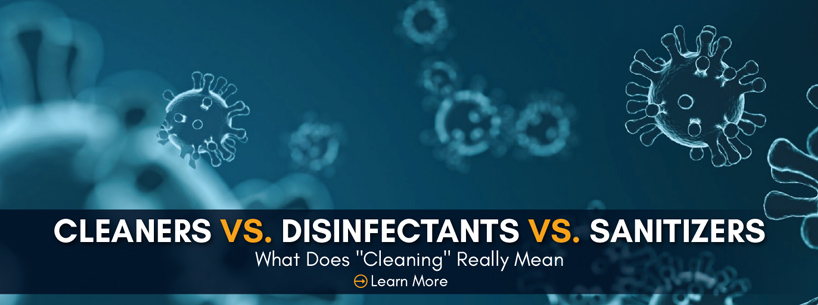Cleaning vs. Disinfecting vs. Sanitizing
At times, when some folks are looking for a cleaning product, terms like “cleaner,” “disinfectant,” and “sanitizer” are used interchangeably– which… well, can be problematic. To help clear up any potential confusion with these terms, we’re here to break things down when it comes to cleaning a surface and how utilizing each method differs from one another so you can be armed with accurate info for further developing your cleaning program!
We just want you to be armed with knowledge so they can make informed decisions and better serve their personnel and customers. It’s very important that you clean surfaces and objects that experience high touch rates regularly (i.e. door knobs, light switches, keypads, fridges, etc.).
Every facility shares in this responsibility. Gas stations, retailers, restaurants, healthcare facilities and hospitals, fire houses, and, yep, in your own home. Regularly cleaning is just a part of life and here’s a bit of clarification on how exactly these cleaning solutions work so you can pick up the best product for the application.
Cleaner | Removes the Germs
A cleaner, like Spectrum All-Purpose Cleaner, essentially removes germs, dirt, and debris from a surface. The act of cleaning works by making use of a cleaning detergent or soap and water with a rag or wipe. Doing so physically removes germs and bacteria from the surface. Cleaning, using this method, does not necessarily kill germs and bacteria, but it does take them off the surface and/or lowers their overall numbers– in turn, reducing the risk of spreading illnesses or infection. Sometimes, an all-purpose cleaner is all you really need.
To over simplify– Think of the germs on a surface like spilled milk on a countertop. You use a paper towel (all purpose cleaner) to wipe it up (physically removing it), thereby removing the chance of getting milk on your bowls, plates, or mail that’s touching the countertop. There may still be a slight trace of the milk left, but not enough to be a major problem. Same concept goes for when you clean germs on a surface with an all purpose cleaner. If germs are picked up and removed from a surface, they can’t be spread.

Disinfectant | Kills the Germs
Disinfectants, like LavFresh TB, essentially kill germs on a surface and/or object. Disinfecting a surface with chemicals doesn’t necessarily mean you’ve cleaned the surface or removed the germs. You’ve completely killed what’s on the surface, which means, similar to cleaning with an all-purpose cleaner, you’ve reduced the risk of spreading illness or infection. Ideally, disinfecting anything should be done as a follow-up to the act of cleaning.
Let’s go back to over simplifying, that’s kinda fun. This won’t exactly be a perfect comparison but let’s go with spilled soda (germs) this time. You spilled your favorite soda on your counter and you wipe it up (clean) with those same paper towels from earlier. You finish wiping everything up and the countertop is dry. You toss the soaked paper towels and place your hand on the counter while grumbling to yourself “why am I so friggin’ clumsy today?” You then remove your hand and.. what!.. ugh. Now your hand is sticky. The sugar from the soda (stubborn germs) is still on the surface, even after you wiped it up. So you grab another handful of paper towels, half wet, half dry, and proceed to re-clean the surface to remove the stickiness (disinfecting). Theoretically, there shouldn’t be anything left and it’s less likely that you’ll have sticky spots on your countertop. The whole point of this ridiculous analogy is to show how sometimes cleaning properly requires a couple steps to be performed.

Sanitizer | Removes and/or Kills the Germs
Sanitizers, like our 512 Sanitizer, are kind of a mashup between cleaners and disinfectants, though they’re more geared towards public health standards or requirements. Sanitizing a surface or object lowers the number of germs by either cleaning or disinfecting. Again, lowering the risk of spreading germs and/or illnesses. These are commonly used in facilities like kitchens, cafeterias, and on carpets. Mostly in places that see a high-volume of people congregate.

Everyone is completely out of disinfecting products! What do I do?
Being a supplier of cleaners, detergents, disinfectants, and sanitizers, we feel your pain! Normally, we’re well-stocked with everything and are 99.9% able to ship orders same or next day. Then the backorders started to happen. We’re still fulfilling many orders, it’s just taking a bit more time and “oomf” to make it happen.
With the pandemic of the Chinese COVID-19 Coronavirus consuming the world, we’ve had an insane amount of people, companies, and government organizations snatch up all of our supply of disinfectants and sanitizers. So we proceeded to change our operating methods in an effort to help anyone who approaches us. Thing is, our supply chain is also feeling the hurt. No one can keep up with demand. It’s unfortunate and we share in everyone’s frustration but rest assured we are absolutely working to ensure we fulfill each and every order as soon as possible.
All that said, disinfectants and sanitizers are not a magic wand. All-purpose and general cleaners also work wonders to minimize risk of spreading germs (viral or otherwise). Regularly cleaning your facility and adhering to CDC guidelines are great ways to mitigate any chance of infection. Wash your hands, maintain social distancing, don’t touch your face, and simply maintain your good hygiene standards.
All-Purpose Cleaners and standard wet wipes are your friend and should still be used as they do a fantastic job of removing soils and contaminants from surfaces.
We highly recommend contacting us so you can get professional assistance with regards to your cleaning program. We can help you set up your program with best practices and the best products ready to tackle any job.
Source: https://www.cdc.gov/

